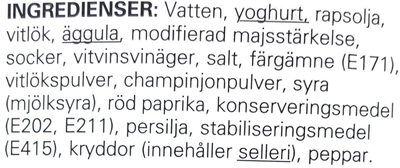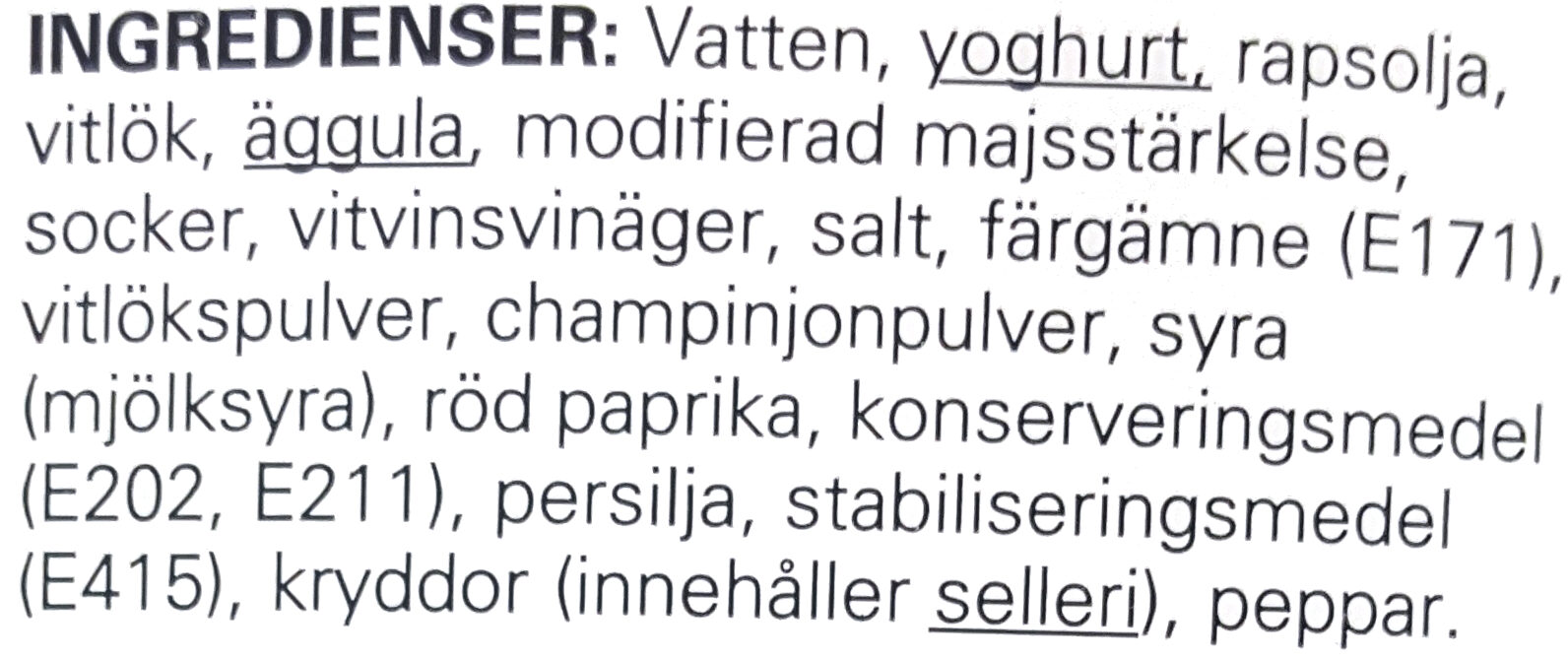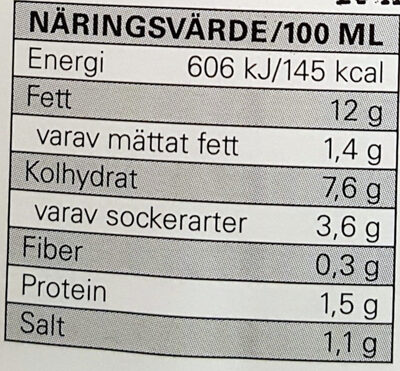Help us make food transparency the norm!
As a non-profit organization, we depend on your donations to continue informing consumers around the world about what they eat.
The food revolution starts with you!
Kebabsås - Eldorado - 320 ml
Kebabsås - Eldorado - 320 ml
This product page is not complete. You can help to complete it by editing it and adding more data from the photos we have, or by taking more photos using the app for Android or iPhone/iPad. Thank you!
×
Streckkod: 7340083458514 (EAN / EAN-13)
Kvantitet: 320 ml
Förpackning: Plast
Kategorier: en:Condiments, Såser, en:Kebab sauces, en:groceries
Tillverknings eller bearbetningsplats: Denmark, Danmark
Butiker: Hemköp
Länder där såld: Sverige
Matching with your preferences
Hälsa
Ingredienser
-
24 ingredienser
Vatten, yoghurt, rapsolja, vitlök, äggula, modifierad majsstärkelse, socker, vitvinsvinäger, salt, färgämne (E171), vitlökspulver, champinjonpulver, syra (mjölksyra), röd paprika, konserveringsmedel (E202, E211), persilja, stabiliseringsmedel (E415), kryddor (innehåller selleri), peppar.Allergener: Selleri, Ägg, Mjölk
Food processing
-
Ultra processed foods
Elements that indicate the product is in the 4 - Ultra bearbetade livsmedel och drycker group:
- Tillsats: E171 - Titandioxid
- Tillsats: E415 - Xantangummi
- Ingrediens: Färg
Food products are classified into 4 groups according to their degree of processing:
- Obearbetade eller minimalt bearbetade livsmedel
- Bearbetade kulinariska ingredienser
- Halvfabrikat
- Ultra processed foods
The determination of the group is based on the category of the product and on the ingredients it contains.
Tillsatser
-
E171 - Titandioxid
Titanium dioxide: Titanium dioxide, also known as titaniumIV oxide or titania, is the naturally occurring oxide of titanium, chemical formula TiO2. When used as a pigment, it is called titanium white, Pigment White 6 -PW6-, or CI 77891. Generally, it is sourced from ilmenite, rutile and anatase. It has a wide range of applications, including paint, sunscreen and food coloring. When used as a food coloring, it has E number E171. World production in 2014 exceeded 9 million metric tons. It has been estimated that titanium dioxide is used in two-thirds of all pigments, and the oxide has been valued at $13.2 billion.Källa: Wikipedia (Engelska)
-
E202 - Kaliumsorbat
Potassium sorbate: Potassium sorbate is the potassium salt of sorbic acid, chemical formula CH3CH=CH−CH=CH−CO2K. It is a white salt that is very soluble in water -58.2% at 20 °C-. It is primarily used as a food preservative -E number 202-. Potassium sorbate is effective in a variety of applications including food, wine, and personal-care products. While sorbic acid is naturally occurring in some berries, virtually all of the world's production of sorbic acid, from which potassium sorbate is derived, is manufactured synthetically.Källa: Wikipedia (Engelska)
-
E211 - Natriumbensoat
Sodium benzoate: Sodium benzoate is a substance which has the chemical formula NaC7H5O2. It is a widely used food preservative, with an E number of E211. It is the sodium salt of benzoic acid and exists in this form when dissolved in water. It can be produced by reacting sodium hydroxide with benzoic acid.Källa: Wikipedia (Engelska)
-
E270 - Mjölksyra
Lactic acid: Lactic acid is an organic compound with the formula CH3CH-OH-COOH. In its solid state, it is white and water-soluble. In its liquid state, it is colorless. It is produced both naturally and synthetically. With a hydroxyl group adjacent to the carboxyl group, lactic acid is classified as an alpha-hydroxy acid -AHA-. In the form of its conjugate base called lactate, it plays a role in several biochemical processes. In solution, it can ionize a proton from the carboxyl group, producing the lactate ion CH3CH-OH-CO−2. Compared to acetic acid, its pKa is 1 unit less, meaning lactic acid deprotonates ten times more easily than acetic acid does. This higher acidity is the consequence of the intramolecular hydrogen bonding between the α-hydroxyl and the carboxylate group. Lactic acid is chiral, consisting of two optical isomers. One is known as L--+--lactic acid or -S--lactic acid and the other, its mirror image, is D--−--lactic acid or -R--lactic acid. A mixture of the two in equal amounts is called DL-lactic acid, or racemic lactic acid. Lactic acid is hygroscopic. DL-lactic acid is miscible with water and with ethanol above its melting point which is around 17 or 18 °C. D-lactic acid and L-lactic acid have a higher melting point. In animals, L-lactate is constantly produced from pyruvate via the enzyme lactate dehydrogenase -LDH- in a process of fermentation during normal metabolism and exercise. It does not increase in concentration until the rate of lactate production exceeds the rate of lactate removal, which is governed by a number of factors, including monocarboxylate transporters, concentration and isoform of LDH, and oxidative capacity of tissues. The concentration of blood lactate is usually 1–2 mM at rest, but can rise to over 20 mM during intense exertion and as high as 25 mM afterward. In addition to other biological roles, L-lactic acid is the primary endogenous agonist of hydroxycarboxylic acid receptor 1 -HCA1-, which is a Gi/o-coupled G protein-coupled receptor -GPCR-.In industry, lactic acid fermentation is performed by lactic acid bacteria, which convert simple carbohydrates such as glucose, sucrose, or galactose to lactic acid. These bacteria can also grow in the mouth; the acid they produce is responsible for the tooth decay known as caries. In medicine, lactate is one of the main components of lactated Ringer's solution and Hartmann's solution. These intravenous fluids consist of sodium and potassium cations along with lactate and chloride anions in solution with distilled water, generally in concentrations isotonic with human blood. It is most commonly used for fluid resuscitation after blood loss due to trauma, surgery, or burns.Källa: Wikipedia (Engelska)
-
E415 - Xantangummi
Xanthan gum: Xanthan gum -- is a polysaccharide with many industrial uses, including as a common food additive. It is an effective thickening agent and stabilizer to prevent ingredients from separating. It can be produced from simple sugars using a fermentation process, and derives its name from the species of bacteria used, Xanthomonas campestris.Källa: Wikipedia (Engelska)
Ingrediensanalys
-
Palmoljefri
No ingredients containing palm oil detected
-
Icke-vegan
Non-vegan ingredients: Yoghurt, Äggula
-
Vegetariskt
No non-vegetarian ingredients detected
-
Details of the analysis of the ingredients
: Vatten, _yoghurt_, rapsolja, vitlök, _äggula_, modifierad majsstärkelse, socker, vitvinsvinäger, salt, färgämne (e171), vitlöks, champinjonpulver, syra (mjölksyra), röd paprika, konserveringsmedel (e202, e211), persilja, stabiliseringsmedel (e415), kryddor, peppar- Vatten -> en:water - vegan: yes - vegetarian: yes - ciqual_food_code: 18066 - percent_min: 5.26315789473684 - percent_max: 100
- _yoghurt_ -> en:yogurt - vegan: no - vegetarian: yes - ciqual_proxy_food_code: 19593 - percent_min: 0 - percent_max: 50
- rapsolja -> en:rapeseed-oil - vegan: yes - vegetarian: yes - from_palm_oil: no - percent_min: 0 - percent_max: 33.3333333333333
- vitlök -> en:garlic - vegan: yes - vegetarian: yes - ciqual_food_code: 11000 - percent_min: 0 - percent_max: 25
- _äggula_ -> en:egg-yolk - vegan: no - vegetarian: yes - ciqual_food_code: 22002 - percent_min: 0 - percent_max: 20
- modifierad majsstärkelse -> en:modified-corn-starch - vegan: yes - vegetarian: yes - ciqual_food_code: 9510 - percent_min: 0 - percent_max: 16.6666666666667
- socker -> en:sugar - vegan: yes - vegetarian: yes - ciqual_proxy_food_code: 31016 - percent_min: 0 - percent_max: 3.6
- vitvinsvinäger -> en:white-wine-vinegar - vegan: yes - vegetarian: yes - ciqual_food_code: 11018 - percent_min: 0 - percent_max: 3.6
- salt -> en:salt - vegan: yes - vegetarian: yes - ciqual_food_code: 11058 - percent_min: 0 - percent_max: 1.1
- färgämne -> en:colour - percent_min: 0 - percent_max: 1.1
- e171 -> en:e171 - vegan: yes - vegetarian: yes - percent_min: 0 - percent_max: 1.1
- vitlöks -> en:garlic - vegan: yes - vegetarian: yes - ciqual_food_code: 11000 - percent_min: 0 - percent_max: 1.1
- champinjonpulver -> en:mushroom-powder - vegan: yes - vegetarian: yes - ciqual_food_code: 20010 - percent_min: 0 - percent_max: 1.1
- syra -> en:acid - percent_min: 0 - percent_max: 1.1
- mjölksyra -> en:e270 - vegan: yes - vegetarian: yes - percent_min: 0 - percent_max: 1.1
- röd paprika -> en:red-bell-pepper - vegan: yes - vegetarian: yes - ciqual_food_code: 20087 - percent_min: 0 - percent_max: 1.1
- konserveringsmedel -> en:preservative - percent_min: 0 - percent_max: 1.1
- e202 -> en:e202 - vegan: yes - vegetarian: yes - percent_min: 0 - percent_max: 1.1
- e211 -> en:e211 - vegan: yes - vegetarian: yes - percent_min: 0 - percent_max: 0.55
- persilja -> en:parsley - vegan: yes - vegetarian: yes - ciqual_proxy_food_code: 11014 - percent_min: 0 - percent_max: 1.1
- stabiliseringsmedel -> en:stabiliser - percent_min: 0 - percent_max: 1.1
- e415 -> en:e415 - vegan: yes - vegetarian: yes - percent_min: 0 - percent_max: 1.1
- kryddor -> en:spice - vegan: yes - vegetarian: yes - percent_min: 0 - percent_max: 1.1
- peppar -> en:pepper - vegan: yes - vegetarian: yes - percent_min: 0 - percent_max: 1.1
Näring
-
Average nutritional quality
⚠ ️Warning: the amount of fruits, vegetables and nuts is not specified on the label, it was estimated from the list of ingredients: 17This product is not considered a beverage for the calculation of the Nutri-Score.
Positiva poäng: 0
- Proteiner: 0 / 5 (värde: 1.5, avrundat värde: 1.5)
- Fiber: 0 / 5 (värde: 0.3, avrundat värde: 0.3)
- Frukt, grönsaker, nötter och raps- / valnöt- / olivoljor: 0 / 5 (värde: 17.7935148540296, avrundat värde: 17.8)
Negativa poäng: 6
- Energi: 1 / 10 (värde: 606, avrundat värde: 606)
- Socker: 0 / 10 (värde: 3.6, avrundat värde: 3.6)
- Mättat fett: 1 / 10 (värde: 1.4, avrundat värde: 1.4)
- Natrium: 4 / 10 (värde: 440, avrundat värde: 440)
The points for proteins are counted because the negative points are less than 11.
Näringsvärde: (6 - 0)
Nutri-Score:
-
Näringsvärden
-
Fett i måttlig kvantitet (12%)
What you need to know- A high consumption of fat, especially saturated fats, can raise cholesterol, which increases the risk of heart diseases.
Recommendation: Limit the consumption of fat and saturated fat- Choose products with lower fat and saturated fat content.
-
Mättat fett i låg kvantitet (1.4%)
What you need to know- A high consumption of fat, especially saturated fats, can raise cholesterol, which increases the risk of heart diseases.
Recommendation: Limit the consumption of fat and saturated fat- Choose products with lower fat and saturated fat content.
-
Sockerarter i låg kvantitet (3.6%)
What you need to know- A high consumption of sugar can cause weight gain and tooth decay. It also augments the risk of type 2 diabetes and cardio-vascular diseases.
Recommendation: Limit the consumption of sugar and sugary drinks- Sugary drinks (such as sodas, fruit beverages, and fruit juices and nectars) should be limited as much as possible (no more than 1 glass a day).
- Choose products with lower sugar content and reduce the consumption of products with added sugars.
-
Salt i måttlig kvantitet (1.1%)
What you need to know- A high consumption of salt (or sodium) can cause raised blood pressure, which can increase the risk of heart disease and stroke.
- Many people who have high blood pressure do not know it, as there are often no symptoms.
- Most people consume too much salt (on average 9 to 12 grams per day), around twice the recommended maximum level of intake.
Recommendation: Limit the consumption of salt and salted food- Reduce the quantity of salt used when cooking, and don't salt again at the table.
- Limit the consumption of salty snacks and choose products with lower salt content.
-
-
Näringsfakta
Näringsfakta Som såld
för 100 g / 100 mlCompared to: en:Kebab sauces Energi 606 kj
(145 kcal)−53 % Fett 12 g −61 % Mättat fett 1,4 g −57 % Kolhydrat 7,6 g +50 % Sockerarter 3,6 g +20 % Fiber 0,3 g Protein 1,5 g +4 % Salt 1,1 g −11 % Fruits‚ vegetables‚ nuts and rapeseed‚ walnut and olive oils (estimate from ingredients list analysis) 17,794 %
Miljö
-
Eco-Score B - Låg miljöpåverkan
The Eco-Score is an experimental score that summarizes the environmental impacts of food products.→ The Eco-Score was initially developped for France and it is being extended to other European countries. The Eco-Score formula is subject to change as it is regularly improved to make it more precise and better suited to each country.Life cycle analysis
-
Average impact of products of the same category: A (Score: 83/100)
Kategori: Kebab sauce, prepacked
Kategori: Kebab sauce, prepacked
- PEF environmental score: 0.25 (the lower the score, the lower the impact)
- including impact on climate change: 1.90 kg CO2 eq/kg of product
Stage Impact Jordbruk
58.1 %Bearbetar
22.1 %Förpackning
7.8 %Transportation
7.4 %Distribution
3.7 %Consumption
1.0 %
Bonuses and maluses
-
Missing origins of ingredients information
Malus: -5
⚠ ️ The origins of the ingredients of this product are not indicated.
If they are indicated on the packaging, you can modify the product sheet and add them.
If you are the manufacturer of this product, you can send us the information with our free platform for producers.
-
Packaging with a medium impact
Malus: -10
Form Material Återvinning Impact Okänd Plast Hög ⚠ ️ The information about the packaging of this product is not sufficiently precise (exact shapes and materials of all components of the packaging).⚠ ️ For a more precise calculation of the Eco-Score, you can modify the product page and add them.
If you are the manufacturer of this product, you can send us the information with our free platform for producers.
Eco-Score for this product
-
Impact for this product: B (Score: 68/100)
Produkt: Kebabsås - Eldorado - 320 ml
Life cycle analysis score: 83
Sum of bonuses and maluses: -15
Final score: 68/100
-
Carbon footprint
-
Equal to driving 1.0 km in a petrol car
190 g CO² per 100g of product
The carbon emission figure comes from ADEME's Agribalyse database, for the category: Kebab sauce, prepacked (Source: ADEME Agribalyse Database)
Stage Impact Jordbruk
61.3 %Bearbetar
14.7 %Förpackning
9.3 %Transportation
12.2 %Distribution
2.1 %Consumption
0.4 %
Förpackning
-
Packaging with a medium impact
-
Packaging parts
Okänd (Plast)
-
Packaging materials
Material % Packaging weight Packaging weight per 100 g of product Plast
-
Transportation
-
Origins of ingredients
Missing origins of ingredients information
⚠ ️ The origins of the ingredients of this product are not indicated.
If they are indicated on the packaging, you can modify the product sheet and add them.
If you are the manufacturer of this product, you can send us the information with our free platform for producers.Add the origins of ingredients for this product Add the origins of ingredients for this product
Report a problem
-
Incomplete or incorrect information?
Category, labels, ingredients, allergens, nutritional information, photos etc.
If the information does not match the information on the packaging, please complete or correct it. Open Food Facts is a collaborative database, and every contribution is useful for all.
Datakällor
Produkt tillagd den av akitainu
Senast ändrad produktsida på av ecoscore-impact-estimator.
Produktsida också redigerad av openfoodfacts-contributors, packbot.












